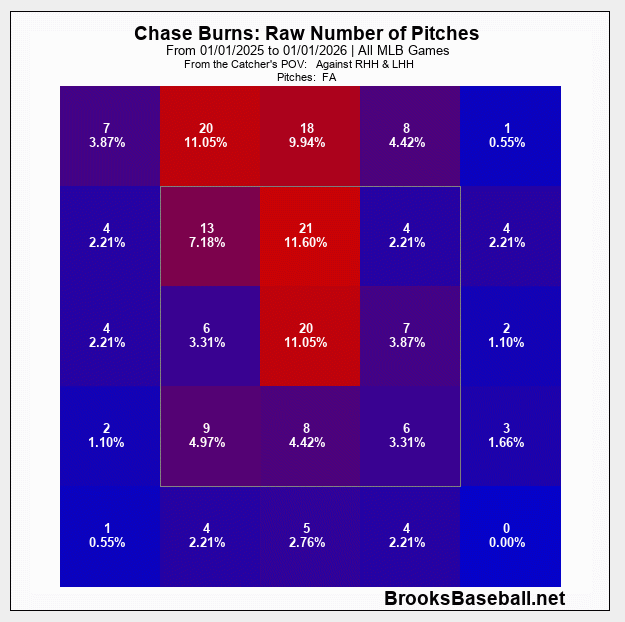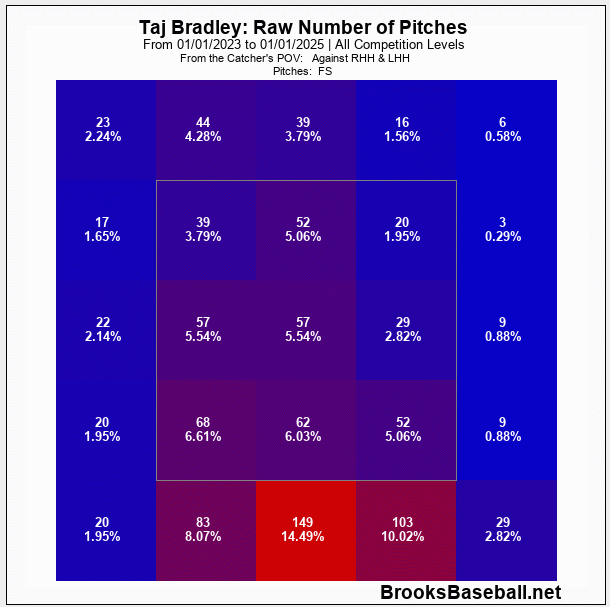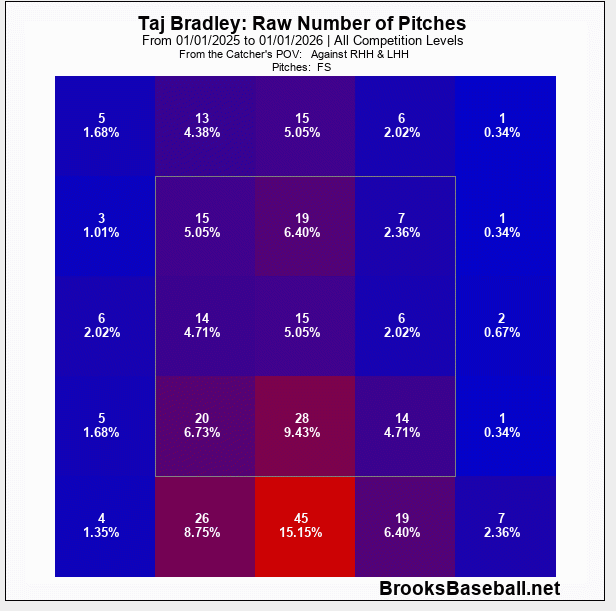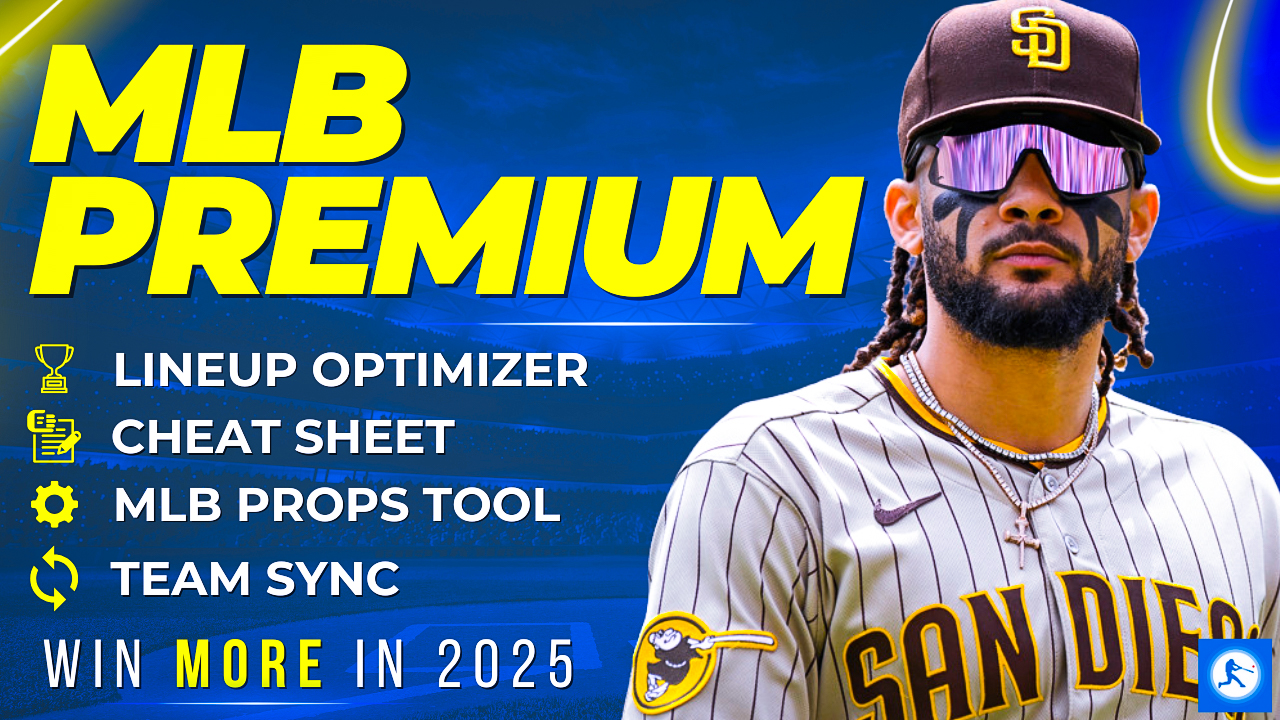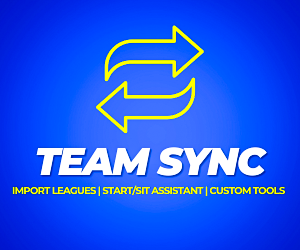Elliott looks at pitchers with surprising starts recently. These SPs could emerge as fantasy baseball waiver wire targets for Week 16 in 2025, or just mirages.
Welcome back to the "Are You For Real?" series as we dive into Week 16 of the 2025 fantasy baseball season. For those unfamiliar, this is a weekly column where we examine starting pitchers who had surprisingly strong starts over the past week and put them under the microscope to determine whether they're legitimate or just smoke and mirrors.
The All-Star break is here, and while none of the pitchers we're talking about today made the team, they certainly pitched like All-Stars last week. This week, we're looking at two young, highly touted arms and one journeyman who may've finally found a home. First, we'll deep dive into Cincy flamethrower Chase Burns. Then, we'll put Tampa's Taj Bradley under the microscope. We'll finish it off by taking a look at Janson Junk's strong performances in Miami.
Roster percentages are taken from Yahoo! and are accurate as of July 13.
Be sure to check all of our fantasy baseball lineup tools and resources:- Fantasy baseball trade analyzer
- BvP matchups data (Batter vs. Pitcher)
- PvB matchups data (Pitcher vs. Batter)
- Who should I start? Fantasy baseball comparisons
- Daily MLB starting lineups
- Fantasy baseball closer depth charts
- Fantasy Baseball live scoreboard
- Fantasy baseball injury reports
Chase Burns, Cincinnati Reds – 55% Rostered
2025 Stats (prior to this start): 10 IP, 8.10 ERA, 4.48 FIP, 18.4% K-BB%
7/11 vs. COL: 6 IP, 4 H, 2 ER, 3 BB, 10 K
Burns was whiffing batters left and right on Friday, fanning a career-high 10 hitters in the no-decision against Colorado. A huge prospect coming into the season, Burns has been volatile since being promoted last month, but Friday was his best showing so far. It doesn’t get much easier than facing the Rockies at home, but this start still ought to raise a few eyebrows. Is Burns ready to break out, or was this just a talented arm taking advantage of a weak opponent?
The second overall pick in 2024, Burns came into the season as Cincinnati’s top prospect and the 27th overall prospect in baseball according to Fangraphs. Burns is known for his heat, with the ability to touch 100 on the gun. He works with a four-pitch mix consisting of a four-seam fastball, slider, changeup, and curveball.
His most-used pitch has been the four-seam fastball, a pitch he throws at an average of 98.1 mph. It’s not just about velocity for Burns, however, as the young righty also has above-average spin at 2617 RPM and above-average vertical movement. His horizontal break is also below league average, which gives the pitch an atypical shape. Here’s a look at his movement profile from this season (four-seamer in red).
It deviates from league average quite a bit, which can make the pitch especially hard to square up for opposing hitters. In fact, Burns has a 28-degree average launch angle and a 66.7% infield fly-ball rate with the pitch. Infield flyballs are practically guaranteed outs, so it’s a very favorable outcome for a pitcher.
Burns has gotten plenty of infield flyballs, but he’s also given up his share of hits with his fastball, too. Batters are hitting .294 off the pitch with a 92.1 mph average exit velocity, albeit with zero extra-base hits and a .343 wOBA. Burns could be susceptible to more power against him if these batted ball trends continue; he’s giving up lots of hard contact, and batters have a ridiculous 34.8% line drive rate off the fastball so far. It’s a small sample size, so I’m sure that line drive rate will correct, and it better because a nearly 35% line drive rate is unsustainable for a major league starter.
Despite a potential susceptibility to power and hard hits, Burns’s fastball has gotten a healthy amount of whiffs for him since being promoted. He got eight of his 15 whiffs with the fastball on Friday, and he has a solid 23.1% whiff rate with his four-seamer this season. Burns has been going after hitters with his fastball, not afraid with a 59.7% zone rate. He keeps the pitch high around the upper part of the zone. Here’s a look at his fastball heatmap from this season.
High heat is what we like to see, as high fastballs with good velocity and spin can create the illusion of rise, causing hitters to swing under the pitch and look foolish. Burns’s fastball was highly touted coming up, and the pitch has all the makings of a dominant fastball, even if Burns hasn’t quite put it all together yet.
His next most-used pitch has been the slider, which Burns throws 33.1% of the time. He threw the pitch 36% of the time against Colorado. A hard slider at 89.9 mph, Burns has both plus movement and spin with this pitch. Here’s an example from this start.
— Elliott Baas (@ElliottBaasBB) July 13, 2025
That’s pretty nasty, and Burns has had no issue throwing the pitch to left-handed batters. It’s proven mostly effective, as opponents have a .182 batting average and a .184 xBA off the pitch, but batters have crushed a little power off the slider with two home runs and a .591 SLG already. We’re still in a minimal sample size for Burns, so these numbers could normalize, but he is allowing a 90.6 mph average exit velocity with the pitch. Batters don’t often make contact as Burns has a 43.5% whiff rate with the pitch, but they do tend to hit the pitch hard when they do hit it.
This slider looks like it could be the perfect complement to Burns’s nasty fastball, and I could see Burns posting some gaudy strikeout numbers in the majors. His current 33.8% K rate is probably unsustainable, but he has the stuff to have a double-digit K/9.
We haven’t seen much of his other two pitches, the changeup and curveball. He’s thrown each less than 5% of the time this season, and he only threw two curveballs and zero changeups against the Rockies. His curveball got some praise from scouts, but he’s only thrown six of them at the major league level, making it hard to gauge the pitch’s measurables.
I think it’ll come down to trusting and incorporating one or both of these pitches more frequently into his sequencing. The fastball-slider combo looks incredible, but two-pitch pitchers aren’t often long for MLB, even when the two pitches are outstanding ones. Burns has displayed excellent command in the minor leagues, and he’s a talented kid. I’m sure that with some seasoning, he’ll be able to wield the curveball and changeup effectively.
Verdict:
Burns is a must-add in all formats; the stuff is simply too good to pass up. His repertoire is limited right now, as he’s mostly relying on four-seam fastballs and sliders, both of which are nasty pitches. He’s going to be volatile as we’ve seen so far, so I’m not ready to trust him every time out yet, but this is talent I’d want on my team.
Use him situationally for now, as he’d be best deployed against weak opponents like Colorado or when the fantasy manager is playing catch-up in a weekly format. He could go out and fan 10 batters like we saw on Friday, but he could also go out and surrender seven runs (five earned) while recording just one out, like we saw a few weeks ago against Boston.
Taj Bradley, Tampa Bay Rays – 45% Rostered
2025 Stats (prior to this start): 97.2 IP, 4.79 ERA, 4.22 FIP, 11.4% Rostered
7/10 @ BOS: 6 IP, 2 H, 1 ER, 3 BB, 5 K
Bradley was outstanding Thursday night, holding Boston to just one run on two hits in one of his best outings all season. It’s been an up-and-down year for Bradley, but mostly bad for the young right-hander, who lowered his ERA to 4.60 following this start. Bradley had some hype as a high-upside third-year youngster coming into the season, but he hasn’t lived up to expectations. Was this him turning the corner, or just a mirage?
Originally a fifth-round pick by Tampa back in 2018, Bradley became a huge prospect by dominating the minor leagues. He posted a 1.83 ERA with a 10.71 K/9 across all levels in 2022 and a 2.57 ERA with a 9.52 K/9 across all levels in 2023. Bradley has had his ups and downs in the major leagues. His ratios are ugly, with a 4.75 ERA, 1.29 WHIP, and 4.40 FIP in 242.2 innings coming into 2025, but he has a 10.5 K/9 over that same period. Bradley works with a four-pitch mix consisting of a four-seam fastball, cutter, splitter, and curveball.
His most-used pitch this season has been the four-seam fastball, which Bradley throws 46.2% of the time. A 96.2 mph offering, Bradley’s fastball has slightly above average vertical movement, average horizontal movement, and spin. His fastball usage has been trending up, and Bradley has used his fastball about 50% of the time over his last 10 starts. He cranked up his usage against Boston, throwing the heater 62.5% of the time, a season high.
It's sort of curious that Bradley has been increasing his fastball usage, because it’s been his most hittable pitch all season. Opponents are batting .284 with a .479 SLG and .384 wOBA off Bradley’s four-seamer this season. This isn’t too far off his career marks with the pitch, but keep in mind that he has a career 4.70 ERA. The problem with Bradley’s fastball is that it’s mostly velocity, and while 96.2 mph is good, major league hitters can handle that kind of heat.
He tries to keep it in the zone, but batters are making more contact and whiffing less at this pitch. Everything is trending wrong with this pitch for Bradley. His contact (81.4% in 2024 > 85.8% in 2025) and zone contact rates (84.8% > 91%) are up, and his chase rates (34.2% > 24.5%) and swinging strike rates (10.3% > 7.1%) are down. The fastball has never been one of Bradley’s best-performing pitches, but it’s a little concerning to see these downward trends.
His next most-used pitch has been the cutter, which Bradley throws 21.5% of the time. An 89.9 mph offering, Bradley’s cutter has below-average vertical movement and above-average horizontal movement. Batters have struggled against this pitch, hitting .228 with a .329 SLG and .270 wOBA.
The expected stats aren’t as nice, with Bradley posting a .255 xBA, .440 xSLG, and .321 xwOBA with his cutter this season. Batters are swinging through the pitch often, with Bradley sporting a solid 32.1% whiff rate with the pitch. Cutters don’t tend to get as many whiffs as sliders and sweepers, so 32% is a reasonable rate for Bradley. While not an elite pitch, Bradley’s cutter is solidly above average and should be a fine pitch he can mix in, mostly to righties.
Bradley’s splitter has been his best strikeout pitch as a pro, but it has gone through some concerning downward trends this season. A 91.3 mph offering, Bradley’s splitter is characterized by low spin at 1722 RPM, and for its well below average vertical movement. This, along with excellent pitch placement, made it a devastating strikeout pitch, and Bradley had a 41% whiff rate with his splitter in his rookie season back in 2023. This year, he has just a 25.8% whiff rate.
The biggest change for Bradley seems to be pitch placement. His zone rate with the splitter has risen to 54.6%, almost as high as his four-seam fastball. The contact rate is up to 77%, and the chase rate has fallen to 26.4%. This is not what we want to see, especially since Bradley is a young pitcher with big talent in his arm. Let’s compare the splitter heatmaps from 2023-24 to this season, and see what’s changed.
2023-24:
2025:
Not a drastic difference at first glance, but take a look at the bottom middle and the upper middle sections of the zone. He’s leaving the pitch up too often, and he isn’t getting the whiffs as a result. His walk rate is up slightly this season as well, to 9.2%. Perhaps Bradley is struggling with command, and that is leading to these less desirable outcomes.
Batters are still hitting just .225 off the splitter with a -3-degree average launch angle and a 63.5% ground-ball rate, so it’s not all doom and gloom for Bradley. But I don’t think we’ll see the same strikeout numbers out of Bradley with his current approach. He had a 10.5 career K/9 coming into this season, but just a 7.73 K/9 this year.
Bradley rounds out his repertoire with a curveball, which has been outstanding this season. He’s only thrown the pitch 14.5% of the time, making it his least-used pitch, but it’s been incredible. Batters are hitting just .106 off the curveball with a .128 SLG and a .115 wOBA. Bradley has done a great job limiting hard contact against this pitch, as batters have an 82.8 mph average exit velocity and a -3-degree average launch angle against.
In fact, the expected stats fully support Bradley’s curveball performance thus far. He has a .104 xBA, .148 xSLG, and a .121 xwOBA with his curveball this season. He also has an impressive 31.9% whiff rate with the pitch, which is pretty good for a curveball. Again, he didn’t really use this pitch or the splitter too much against Boston. Perhaps that was because the fastball and cutter were working for him, but I’d like to see more curveball usage from Bradley going forward. The splitter isn’t working for him the way it once did, and he won’t survive with just a fastball and cutter, so why not?
Verdict:
Bradley has had some hype around his name the past few years, but unfortunately, he is trending in the wrong direction. Strikeouts are down, walks are up, FIP and SIERA are up. What’s killing his strikeout rate is poor command with his splitter, as it’s staying in the zone too much and no longer deceiving hitters. He throws with decent heat at 96.2 mph, but with poor movement and spin, his fastball is still hittable for major leaguers. The curveball has strong numbers this season, and I’d like to see him use it more often, but that was not the case against Boston, as he only threw six curveballs and five splitters.
Bottom line, I don’t think the fastball-cutter approach is the path to big success for Bradley, and right now, he is only usable as the occasional streamer. Those hoping he will recapture his strikeout rates from past years will be disappointed, and without the strikeouts, all he’s good for is a bloated ERA and a bloated WHIP. Name value may keep his roster rate relatively high, but he’s someone I would consider dropping for a more exciting arm if one emerges in your league.
Janson Junk, Miami Marlins – 19% Rostered
2025 Stats (prior to this start): 43.1 IP, 3.12 ERA, 2.00 FIP, 18.7% K-BB%
7/12 @ BAL: 7 IP, 5 H, 0 ER, 0 BB, 2 K
Junk has been anything but since joining the Marlins rotation, and the good times continued on Saturday with a dominant start against Baltimore. Junk blanked the Orioles over seven innings for his third consecutive quality start. He has a 2.60 ERA and a 2.58 FIP in five starts since joining the rotation on 6/14. Is the journeyman Junk emerging as a viable fantasy option, or should we discard him?
Originally a 22nd-round pick by the Yankees back in 2017, it’s safe to say that Junk was not a big prospect, especially compared to the other pitchers we’re covering this week. Miami is his sixth organization since being drafted, and he’s been traded twice and DFA’d three times. Junk works with a five-pitch mix consisting of a four-seam fastball, slider, sweeper, curveball, and changeup.
His most-used pitch has been the four-seam fastball, which Junk throws 38.4% of the time. A 93.9 mph offering, Junk’s fastball has below-average velocity and average spin at 2292 RPM. Batters have hit .250 off the pitch with a .344 SLG and a .269 wOBA. Solid numbers, but I’m not sure how sustainable they are. Junk has a .275 xBA, .401 xSLG, and .302 xwOBA with his fastball this season. Still okay numbers, but not as good as he’s performed thus far.
One area of concern with the fastball is how much hard contact Junk is allowing. Batters have a blistering 93.1 mph average exit velocity off Junk’s four-seamer, along with a 35.4% line drive rate. That combination tends to be conducive for hits, and Junk would have a hard time maintaining the .250 AVG against his four-seamer with this batted ball profile.
His most used pitch may be the fastball, but Junk’s best pitch has been the sweeper, which he throws 15.2% of the time, mostly to righties. An 82.2 mph offering, Junk’s sweeper is softer than his slider, with more prominent drop and break. Batters are hitting just .172 off the pitch with a .172 SLG and a .148 wOBA.
It’s also been Junk’s best strikeout pitch, though his 24.6% whiff rate is underwhelming. Like with the fastball, I’m not sure Junk can sustain this performance. He has a .235 xBA and .375 xSLG, and batters have a 90.3 mph average exit velocity off the sweeper. I’m not saying the bottom will fall out completely, but regression will likely occur for Junk on his sweeper.
His slider hasn’t performed as well as the sweeper, but has still been solid for Junk. It’s harder than the sweeper, with average movement and spin. Batters are hitting .246 off the pitch with a .311 SLG and a .256 wOBA. Again, the numbers suggest that this performance is not sustainable. Junk has a .302 xBA, .443 xSLG, and .331 xwOBA off the pitch.
He has a softer average exit velocity at 87.3 mph, but he is giving up a 13-degree average launch angle. 13 degrees is line drive territory, and it’s not where a pitcher wants to be. Sliders tend to be big strikeout pitches, but that’s not the case for Junk, who has just a 22.6% whiff rate with his slider this season. He only got five whiffs on Saturday, including just one with the slider.
The stuff is underwhelming for Junk; there’s a reason he’s been passed around the league so much. That being said, he does have some valuable skills on the mound that could give him some fantasy appeal. He has displayed excellent control this season, with a microscopic 2% walk rate this year. He’s allowed just four walks all season, and only two as a starter. This walk rate is too low to last, but it’s a great skill that Junk has displayed so far, and he could be a WHIP helper thanks to his strike-throwing ability.
Junk also has been pitching deep into games, partly because of his efficiency. He throws so many strikes and doesn’t work deep into counts too often, keeping his pitch count down. He’s tossed three straight quality starts, and he could be great for a QS league, even if he won’t get many wins in Miami. He’s also done a great job limiting home runs, having allowed just one all season. I don’t expect his 1.9% HR/FB ratio to last, especially with his overall 92 mph average exit velocity, but if Junk can limit walks and the long ball, he could have some value.
Verdict:
Is Janson junk? Not quite, as he’s displayed some positive attributes in limited appearances. Junk has done two things extremely well, and that’s limiting walks and home runs. I’m not sure a 2% BB rate or a 1.9% HR/FB rate are sustainable over a long period, but if Junk can be above average, he could carve out a role for himself. He’s on a bad team, but he’s efficient on the mound and can pitch deep into games, giving him chances for quality starts.
He could also be a great WHIP helper in certain contexts thanks to his ability to limit baserunners. The stuff itself is a little underwhelming. His fastball is below average, and the sweeper has been his only standout pitch so far. He’s sort of a junk-baller (pun definitely intended), but one with enough skills to have fantasy value in deeper leagues or as a streamer.
More Fantasy Baseball Advice
Download Our Free News & Alerts Mobile App
Like what you see? Download our updated fantasy baseball app for iPhone and Android with 24x7 player news, injury alerts, sleepers, prospects & more. All free!






 RADIO
RADIO









